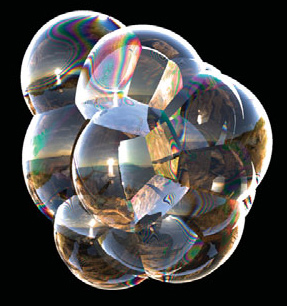Heady mathematics: Describing popping bubbles in a foam
Bubble baths and soapy dishwater, the refreshing head on a beer and the luscious froth on a cappuccino. All are foams, beautiful yet ephemeral as the bubbles pop one by one.
Two University of California, Berkeley, researchers have now described mathematically the successive stages in the complex evolution and disappearance of foamy bubbles, a feat that could help in modeling industrial processes in which liquids mix or in the formation of solid foams such as those used to cushion bicycle helmets.

Applying these equations, they created mesmerizing computer-generated movies showing the slow and sedate disappearance of wobbly foams one burst bubble at a time.
The applied mathematicians, James A. Sethian and Robert I. Saye, will report their results in the May 10 issue of Science. Sethian, a UC Berkeley professor of mathematics, leads the mathematics group at Lawrence Berkeley National Laboratory (LBNL). Saye will graduate from UC Berkeley this May with a PhD in applied mathematics.
“This work has application in the mixing of foams, in industrial processes for making metal and plastic foams, and in modeling growing cell clusters,” said Sethian. “These techniques, which rely on solving a set of linked partial differential equations, can be used to track the motion of a large number of interfaces connected together, where the physics and chemistry determine the surface dynamics.”
The problem with describing foams mathematically has been that the evolution of a bubble cluster a few inches across depends on what’s happening in the extremely thin walls of each bubble, which are thinner than a human hair.
“Modeling the vastly different scales in a foam is a challenge, since it is computationally impractical to consider only the smallest space and time scales,” Saye said. “Instead, we developed a scale-separated approach that identifies the important physics taking place in each of the distinct scales, which are then coupled together in a consistent manner.”
Saye and Sethian discovered a way to treat different aspects of the foam with different sets of equations that worked for clusters of hundreds of bubbles. One set of equations described the gravitational draining of liquid from the bubble walls, which thin out until they rupture. Another set of equations dealt with the flow of liquid inside the junctions between the bubble membranes. A third set handled the wobbly rearrangement of bubbles after one pops.
Using a fourth set of equations, the mathematicians solved the physics of a sunset reflected in the bubbles, taking account of thin film interference within the bubble membranes, which can create rainbow hues like an oil slick on wet pavement. Solving the full set of equations of motion took five days using supercomputers at the LBNL’s National Energy Research Scientific Computing Center (NERSC).
The mathematicians next plan to look at manufacturing processes for small-scale new materials.
“Foams were a good test that all the equations coupled together,” Sethian said. “While different problems are going to require different physics, chemistry and models, this sort of approach has applications to a wide range of problems.”
The work is supported by the Department of Energy, National Science Foundation and National Cancer Institute.
